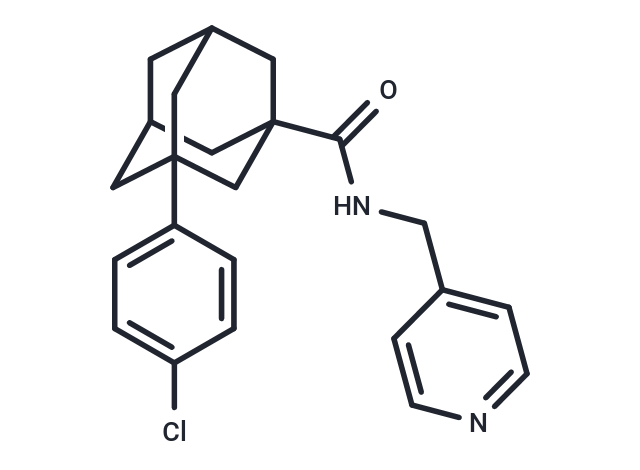购物车
- 全部删除
 您的购物车当前为空
您的购物车当前为空

Opaganib (ABC294640) 是选择性和竞争性的鞘氨醇激酶 2 (SK2) 抑制剂,Ki 为 9.8 μM。

Opaganib (ABC294640) 是选择性和竞争性的鞘氨醇激酶 2 (SK2) 抑制剂,Ki 为 9.8 μM。
| 规格 | 价格 | 库存 | 数量 |
|---|---|---|---|
| 1 mg | ¥ 238 | 现货 | |
| 2 mg | ¥ 343 | 现货 | |
| 5 mg | ¥ 539 | 现货 | |
| 10 mg | ¥ 959 | 现货 | |
| 25 mg | ¥ 1,770 | 现货 | |
| 50 mg | ¥ 2,970 | 现货 | |
| 100 mg | ¥ 5,150 | 现货 | |
| 1 mL x 10 mM (in DMSO) | ¥ 588 | 现货 |
| 产品描述 | Opaganib (ABC294640) is an orally active and specific sphingosine kinase-2 (SphK2) inhibitor (IC50: 60 μM). |
| 靶点活性 | SPHK2:60 μM |
| 体外活性 | ABC294640 markedly alters the ratio of ceramide/S1P consistent with inhibition of SK activity in MDA-MB-231 cells. ABC294640 inhibits tumor cell proliferation with IC50 values ranging from approximately 6 to 48 μM, and impairs tumor cell migration concomitant with loss of microfilaments. [1] ABC294640 induces nonapoptotic cell death, morphological changes in lysosomes, formation of autophagosomes, and increases in acidic vesicles in A-498, PC-3, and MDA-MB-231 cells. [2] In both MCF-7 and ER-transfected HEK293 cells, ABC294640 decreases E2-stimulated ERE-luciferase activity. [3] |
| 体内活性 | In mice bearing mammary adenocarcinoma xenografts, ABC294640 (100 mg/kg, p.o.) significantly reduce tumor growth, associated with depletion of S1P levels. [1] In severe combined immunodeficient mice bearing A-498 xenografts, ABC294640 delays tumor growth and elevates autophagy markers. [2] ABC294640 protects against liver transplantation-induced inflammation and cross-talk between innate and adaptive immunities, major events precipitating and exacerbating graft injury, and improves liver function and survival. [4] |
| 激酶实验 | Sphingosine Kinase Assays: The IC50 values for ABC294640 and DMS are determined by a newly developed HPLC-based SK activity assay. In brief, the test compounds are incubated with recombinant SK1 or SK2 and NBD-Sph in the isozyme-selective assay buffers detailed below with 1 mg/ml fatty acid-free bovine serum albumin, 100 μM ATP, and 400 μM MgCl2. The product, i.e., NBD-S1P, is separated from NBD-Sph by HPLC as follows: Waters 2795 HPLC system with a Waters 2495 fluorescence detector, C8 Chromolith RP-8e column (100 × 4.6 mm), 1 ml/min mobile phase (acetonitrile/20 mM sodium phosphate buffer, pH2.5, at 45:55). Fluorescence is monitored with excitation at 465 nm and emission at 531 nm. The ratio of NBD-S1P/(NBD-Sph + NBD-S1P) is used as a measure of SK activity. SK-isozyme selective assay buffers each contained 20 mM Tris, pH7.4, 5 mM EDTA, 5 mM EGTA, 3 mM β-mercaptoethanol, 5% glycerol, 1× protease inhibitors and 1× phosphatase inhibitors. For the SK1 assay buffer, 0.25% (final) Triton X-100 is added; and for the SK2 buffer, 1 M (final) KCl is added. Assays are run for 2 h at room temperature, and then a 1.5 volume of methanol is added to terminate the kinase reaction. After 10 min, the samples are centrifuged at 20,000 g to pellet the precipitated protein, and the supernatants are analyzed by HPLC. In experiments to determine the Ki for inhibition of SK2 by ABC294640, the ADP Quest assay system is used to measure kinase activity in the presence of varying concentrations of sphingosine and ABC294640. To determine the effects of ABC294640 on cellular SK activity, near-confluent MDA-MB-231 cells are serum-starved overnight, and then treated with varying concentrations of ABC294640. The cells are then incubated with [3H]sphingosine at a final concentration of 1 μM. The cells take up the exogenous sphingosine, which is converted to S1P via SK activity, and [3H]S1P is separated from [3H]sphingosine by extraction and quantified by scintillation counting. |
| 细胞实验 | To determine the effects of the test compounds on proliferation, cells are plated into 96-well microtiter plates and allowed to attach for 24 h. Varying concentrations of ABC294640 are added to individual wells and the cells are incubated for an additional 72 h. At the end of this period, the number of viable cells is determined by use of the sulforhodamine-binding assay. The percentage of cells killed is calculated as the percentage decrease in sulforhodamine-binding compared with control cultures. Regression analyses of inhibition curves are performed by use of GraphPad Prism.(Only for Reference) |
| 别名 | ABC294640 |
| 分子量 | 380.91 |
| 分子式 | C23H25ClN2O |
| CAS No. | 915385-81-8 |
| Smiles | Clc1ccc(cc1)C12CC3CC(CC(C3)(C1)C(=O)NCc1ccncc1)C2 |
| 密度 | 1.273±0.06 g/cm3 (20 °C, 760 mmHg) |
| 存储 | store at low temperature,store under nitrogen,keep away from direct sunlight | Powder: -20°C for 3 years | In solvent: -80°C for 1 year | Shipping with blue ice. | ||||||||||||||||||||||||||||||||||||||||
| 溶解度信息 | Ethanol: 27 mg/mL (70.88 mM), Sonication is recommended. DMSO: 71 mg/mL (186.4 mM), Sonication is recommended. H2O: < 1 mg/mL (insoluble or slightly soluble) | ||||||||||||||||||||||||||||||||||||||||
溶液配制表 | |||||||||||||||||||||||||||||||||||||||||
Ethanol/DMSO
DMSO
| |||||||||||||||||||||||||||||||||||||||||
评论内容